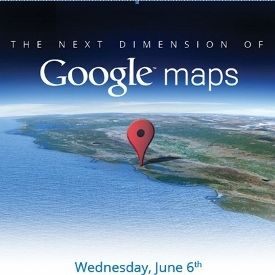By AGRC Staff on Jun 06, 2012
Apple, Google, 3D and GIS
This article will take 4 minutes to read
 The next few days mark an interesting time in the geospatial industry. As geo-guru Peter Batty noted, rarely do a couple of the world's largest companies put maps at the forefront of their competitive strategy like they are this week. ("Finally, maps are relevant!") Earlier in the week, well-placed rumors were headlining that as part of Apple's WWDC next week, it would announce the dismissal of Google Maps as well as introduce a new concept in 3D mapping for mobile. The rumors garnered attention of many major news outlets (NPR, HuffPost, Wall Street Journal).
The next few days mark an interesting time in the geospatial industry. As geo-guru Peter Batty noted, rarely do a couple of the world's largest companies put maps at the forefront of their competitive strategy like they are this week. ("Finally, maps are relevant!") Earlier in the week, well-placed rumors were headlining that as part of Apple's WWDC next week, it would announce the dismissal of Google Maps as well as introduce a new concept in 3D mapping for mobile. The rumors garnered attention of many major news outlets (NPR, HuffPost, Wall Street Journal).
Not to be too outdone by the ubiquitous half-eaten fruit logo, Google "schooled" Apple ahead of WWDC with an announcement of its own, making a splash of its own (Wall Street Journal, LA Times, USA Today, ABC News). Any wide-eyed mapper has already heard that Google is also rolling out a 3-D version of maps as well as some new tricks like downloading zoomable map caches on a mobile device for offline use - long desired functionality.
What's it mean for GIS?
These announcements illustrate that mapping/location is the next frontier in the convergence of mobile and social. However, in the background, significant implications stem from the data that supports these moves. Geographic Information Systems, or GIS, is the backbone to enabling these technologies. Base GIS technology has been around for 40+years. However, the past ten years has been significantly different with the increased connectivity, processing power, expectations raised by use of Google Maps and the like, and now mobile map technologies.
Historically, access to GIS information was limited to those with the skills and technology to work with that information - requiring specialized software and capabilities. These developments in the last ten years have done more to get GIS onto the minds and into the hands of non-specialized users more than anything in the past 40 years. Now, the move to further enhance mobile mapping will continue to make geospatial information even more relevant.
Accessibility
At AGRC, we are taking steps to make the large repository of data we maintain to be more readily available for use by non-GIS professionals. Our newly redesigned website is one example, we have tried to make data more easily understood and accessible. We are building capabilities so that users can access information that doesn't necessarily require special software. In addition, we are building applications so that users can better access and manipulate their information in a mapping environment. Some examples include broadband internet availability, political boundaries, licensed health facilities, and school locations. Much of this data is not new; now it is much more accessible to non-GIS users. Furthermore, free tools such as Google Earth, ArcGIS Online, and OpenStreet Map are enabling the rise of 'neogeography.' We are and will continue to roll out data resources that enable the use of map data in those environments.
Accuracy
As data becomes more accessible, its accuracy and currency becomes more critical. To assist, we are focusing on prioritizing the available resources we have greater confidence in their completeness and accuracy. For example, street centerlines and municipal boundaries are regularly updated by AGRC staff to incorporate changes received from local, state, and federal entities.
Authority
A new feature of the data section of our website is easy access to contact information of the owner or steward of data hosted in the State Geographic Information Database (SGID). For example, Oil and Gas datasets are maintained by the Division of Oil, Gas, and Mining at the Department of Natural Resources. If a user is looking for additional information pertaining to those datasets, they can contact the data owners directly without having to navigate the increasingly unsettled world of structured metadata.
Collaboration
Despite much hype associated with 'the Cloud,' it's already clear that maintenance and provision of mapping data is moving quickly to the much more highly connected environment of data and map services. Many success stories of collaborative map data creation and update exist and they span the full range of citizen involvement to trusted expert-only environments. Sharing the responsibilities for data upkeep and doing so in real time can greatly improve the quality, reach, and cost-effectiveness of the business at hand. We expect this trend to accelerate in the next few years as more enterprises, including many endeavors with longstanding GIS histories, realize the great internal and external value inherent in working in a more inter-connected, collaborative environment.
Some argue that these latest announcements from Apple and Google are not as significant as the news headlines purport. That is understandable because of long-standing issues with data currency, completeness and authority of web mapping resources such as Google and Bing. However, we in the geospatial industry can't help but appreciate the attention this places on mapping and its relevance to today's demand for immediate access to relevant information.